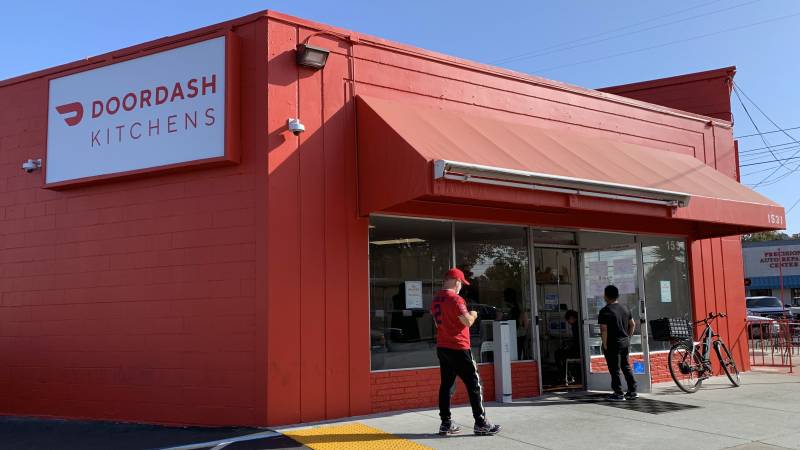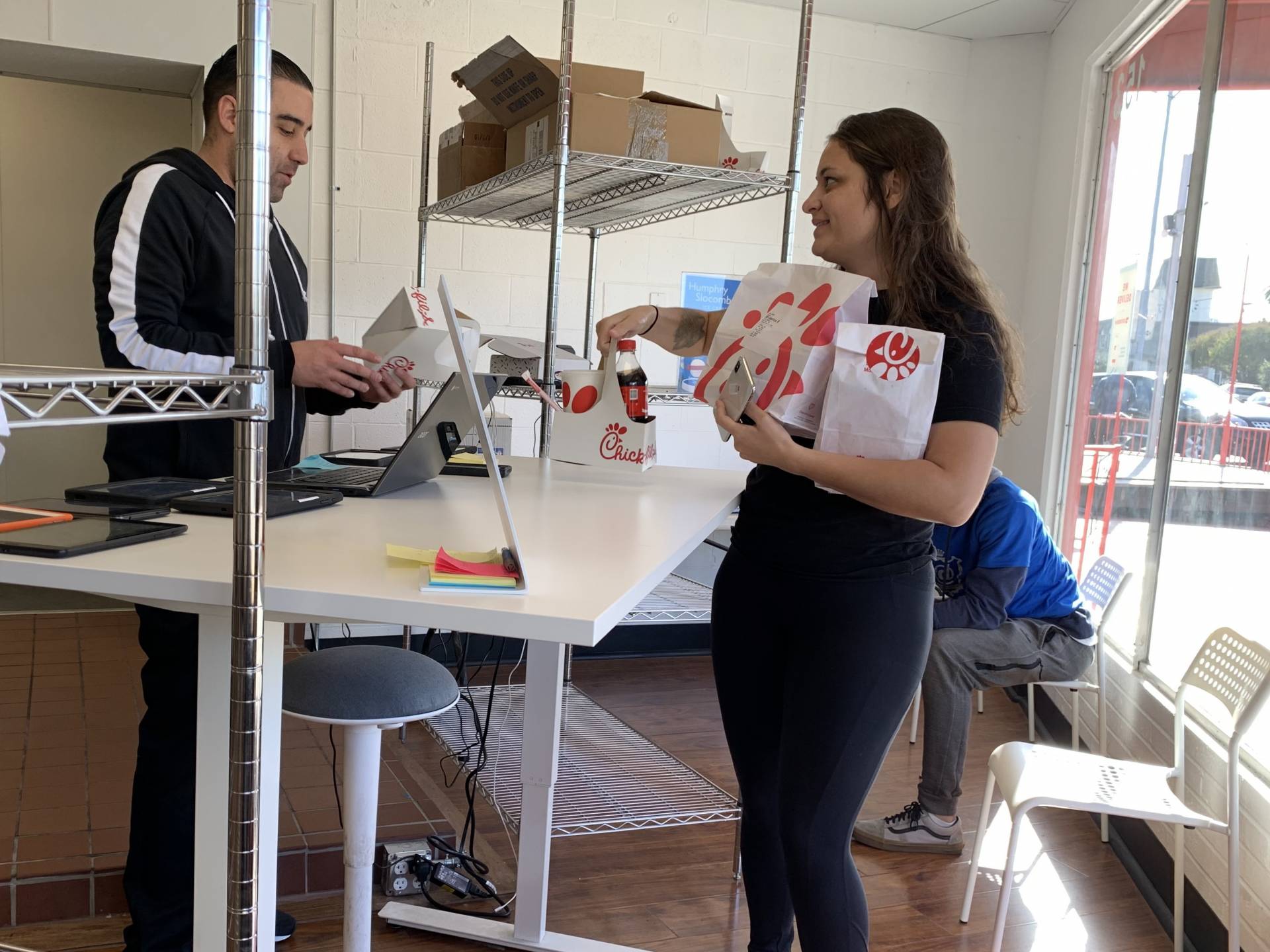Inside a bright red building in Redwood City, just south of San Francisco, cooks plunge baskets of french fries into hot oil, make chicken sandwiches and wrap falafel in pita bread.
Delivery Only: The Rise Of Restaurants With No Diners As Apps Take Orders

If you've been in a restaurant kitchen, it's a familiar scene. But what's missing here are waiters and customers. Every dish is placed in a to-go box or bag.
Delivery drivers line up in a waiting area ready for the name on their order to be called.
Behind the counter, racks of metal shelves hold bags of food. Each bag sports a round, red sticker with the logo of DoorDash, America's biggest food delivery app.
DoorDash manages this building, the drivers, the counter staff — everything but the food, which is made by five restaurants that are renting kitchens here.
"Rather than having to build a physical brick-and-mortar store, we do that on their behalf. And then they move into our DoorDash kitchen and then overnight they're live on the DoorDash platform," said Fuad Hannon, DoorDash's head of new business verticals. He oversees the new kitchen venture.
Not long ago, food delivery in many places was limited to pizza and Chinese takeout.
But now, thanks to apps like DoorDash, Grubhub and Postmates, customers can summon their favorite dish with a tap on a smartphone screen, whether they live in a city or the far-flung suburbs.
"Your customer is just like, at their living room, watching Netflix," said Min Park, an investor in DoorDash tenant Rooster & Rice, a chicken chain with six locations in the Bay Area.
U.S. diners spent almost $27 billion last year ordering food for delivery by app, website or text message, according to the NPD Group, a market researcher. Online delivery is still a small slice of the $800 billion restaurant industry, but it's growing fast.

And money is pouring into delivery-only kitchens. They go by a variety of names, including ghost kitchens, virtual kitchens and dark kitchens.
Kitchen United, based in Pasadena, Calif., has raised $50 million from investors including Google.
Uber co-founder Travis Kalanick has reportedly raised hundreds of millions of dollars from Saudi Arabia for his new business, CloudKitchens.
DoorDash's tenants include national chains, including Chick-fil-A, as well as Bay Area brands, such as the diner Nation's Giant Hamburgers.
None of them have actual restaurants or stores nearby, but the DoorDash facility allows them to deliver to Redwood City and neighboring towns.
This lets Rooster & Rice test new neighborhoods without committing a lot of money to a new restaurant and hiring waiters and other staff, Park said.
"In San Francisco, it could easily cost about $750,000 to $1 million for a medium-sized space," he said. "The commissary kitchen model" can generate similar revenue "at a fraction of the cost," Park said.
Other restaurants are trying a different approach: creating separate menus just for smartphone apps.
Uber Eats is one of the fastest-growing parts of Uber. It knows exactly what food its customers are searching for, and it knows when those searches don't turn up results.
Uber advises some restaurants to use their existing kitchens to offer a whole new menu, under a different name — and only available through the app.
That could mean a bakery that starts making burgers for delivery "because that neighborhood didn't have enough burger restaurants," said Janelle Sallenave, head of Uber Eats in North America.
There are more than 4,000 of these "virtual restaurants" on Uber Eats.
DoorDash similarly looks at the millions of orders it receives to suggest where restaurants should expand delivery and menu items.
The app companies say the restaurants they partner with get a boost from delivery. Restaurants such as Rooster & Rice say those additional sales make up for the costs associated with delivery.
But the restaurant industry has never been easy, and the apps take a big cut from those delivery orders.
Ken Ray knows how that works. He opened Alacarte Delivery in Miami in 2017. He set up a ghost kitchen and began creating menus for the apps.
"Over a 10-month period, we essentially developed 15 different restaurant brands," he said, including Mott Street Pizza, Fresco Mexicano and Whichicken, a rotisserie chicken restaurant.
But without name recognition, it was hard to find customers. On top of that, Ray said the 30% commission most apps charged him for each order they delivered made it impossible for his business to cover its expenses.
"For restaurants, it's tough to give away that 30%. A lot of these guys — the Ubers, the Postmates, the Grubhubs — they've essentially built an amazing business, but they built it off the back of the restaurateur," he said.
He closed Alacarte Delivery in July.
Ray still believes that people have a big appetite for delivery — but it needs to be palatable for restaurants, too.
Copyright 2019 NPR. To see more, visit NPR.org.